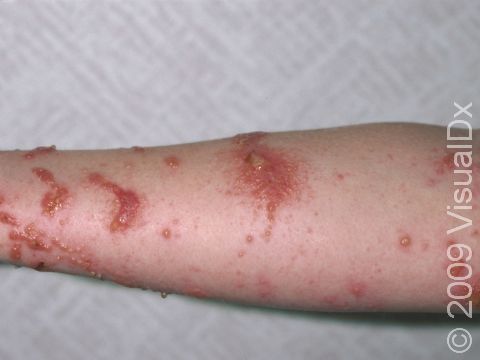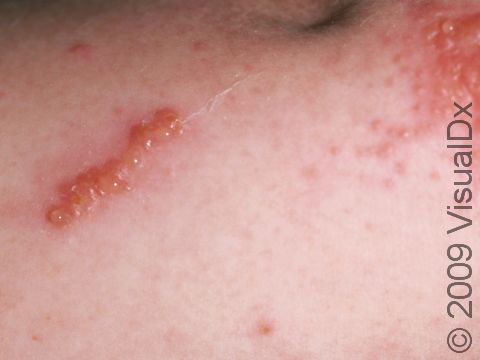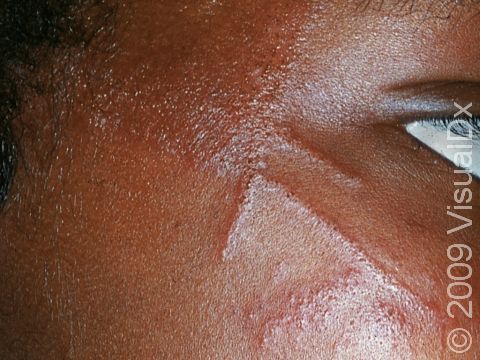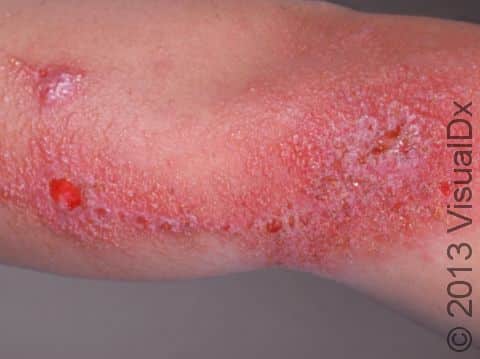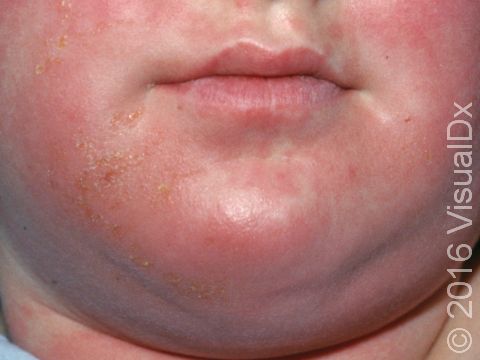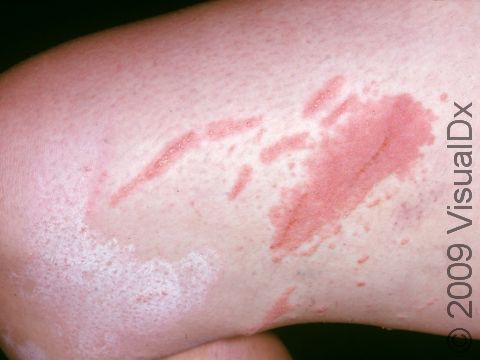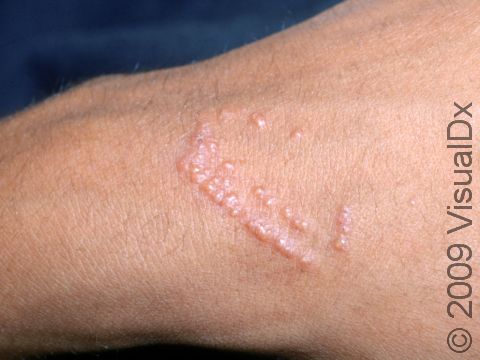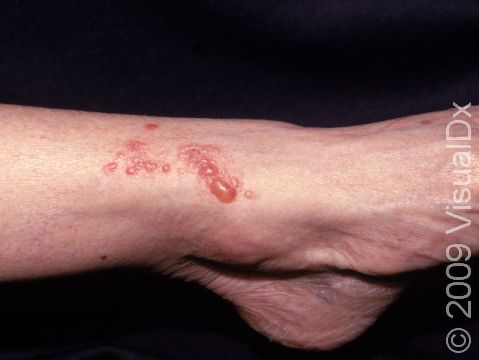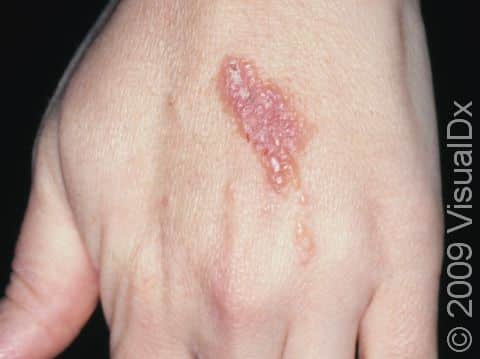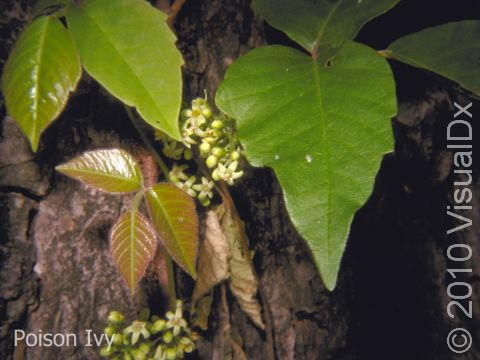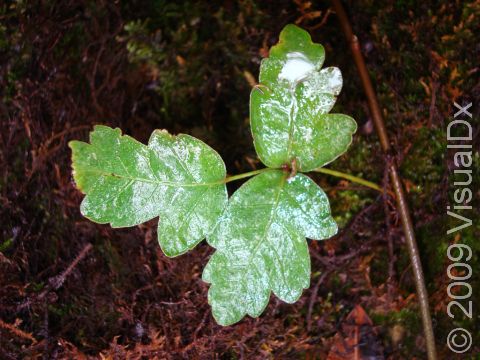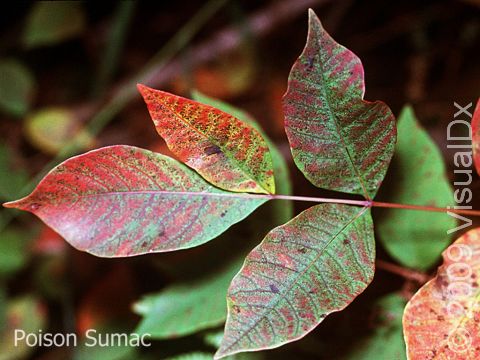Poison Ivy, Oak, and Sumac
Poison ivy, poison oak, and poison sumac rashes (dermatitides) are all allergic reactions to the oily resin called urushiol found on the leaves, stems, and roots of poison ivy, poison oak, and poison sumac plants.
- The reaction results in itchy papules (small, solid bumps), plaques (a raised or bumpy area larger than a thumbnail), vesicles (small blisters), and sometimes bullae (blisters larger than a thumbnail).
- The itch can be intense, and secondary bacterial infection can result from scratching.
- You cannot spread the rash from touching the lesions, even if the blisters pop; the rash is spread by contact with the plant resin itself.
- The rash first appears on the areas of skin exposed to the most oil, and then areas exposed to less oil begin to develop a rash later.
- Skin lesions usually begin to appear 48 hours after exposure if you have had previous contact with urushiol. If it is your first exposure, the reaction may take up to a few weeks to develop.
Who's At Risk?
Poison ivy, poison oak, and poison sumac may affect people of any age, sex, and race / ethnicity.
Signs & Symptoms
- Poison ivy, poison oak, and poison sumac rash can occur anywhere on the body where exposure to the plants has occurred.
- Red and brown-red papules, plaques, and blisters may appear in a linear pattern. The blisters may ooze and become crusted. In darker skin colors, the redness may be harder to see, or it may appear more purple or gray.
- A “black spot” variant has been described, where the oil from the plant leaves one or more black dots on the skin.
- Extreme facial or genital swelling (edema) may be seen when there is significant exposure to these areas.
- The rash may last for weeks.
Self-Care Guidelines
- It is important to use water to wash all potentially exposed skin areas as soon as possible, as the resin of the poison ivy, poison oak, and poison sumac plants sticks to and can be absorbed into the skin within 30 minutes. Be sure to wash under the nails as well.
- Once the resin has been washed off from the skin, there is no risk of spreading poison ivy, poison oak, or poison sumac from one part of the body to another. However, oil left on clothing and other objects, such as gloves, shoes, and camping gear, can last for months, so wash any clothes or other items potentially exposed to the oil as well.
- Pets can also carry the oil on their coats and should be washed thoroughly if exposed to poison ivy, oak, or sumac.
- Wear protective clothing (eg, pants, socks, and long-sleeved shirts) to avoid future reactions. If potentially coming in contact with poison ivy, oak, or sumac, wear protective gloves or apply a protective barrier (eg, IvyX Pre-Contact Poison Skin Solution).
- Cool tap water, soothing oatmeal baths (such as Aveeno Soothing Bath Treatment), and calamine lotion may be helpful in relieving mild symptoms of itch.
- Over-the-counter 1% hydrocortisone cream can help relieve itch in mild cases, as can over-the-counter antihistamines (eg, Zyrtec, Benadryl).
Treatments
Your medical professional may prescribe:
- A medium-to-high-potency topical steroid to treat the trunk, arms, and legs or low-potency topical steroid to treat the face and skinfold areas if the affected areas are fairly limited.
- Prescription oral antihistamines to help relieve itching.
- In severe cases involving large body areas, a 14-to-20-day course of oral steroids (prednisone).
- Topical or oral antibiotics if an infection is suspected.
Visit Urgency
Seek medical help for a rash that does not respond to self-care measures or seems to be getting worse.
Trusted Links
References
Bolognia J, Schaffer JV, Cerroni L. Dermatology. 4th ed. Philadelphia, PA: Elsevier; 2018.
James WD, Elston D, Treat JR, Rosenbach MA. Andrew’s Diseases of the Skin. 13th ed. Philadelphia, PA: Elsevier; 2019.
Kang S, Amagai M, Bruckner AL, et al. Fitzpatrick’s Dermatology. 9th ed. New York, NY: McGraw-Hill Education; 2019.
Last modified on June 26th, 2024 at 2:47 pm

Not sure what to look for?
Try our new Rash and Skin Condition Finder
